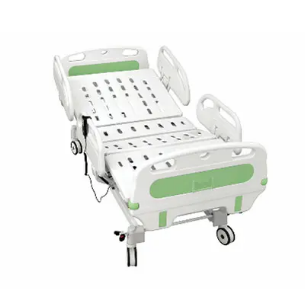Turning over a nursing bed can help patients sit up on their side, bend their lower limbs, and relieve swelling. Suitable for self-care and rehabilitation of various bedridden patients, it can reduce the nursing intensity of medical staff and is a new multifunctional nursing instrument.

The main structure and performance of the roll over nursing bed are as follows:
1. Electric flip
A pile of flipping frame components are installed on the left and right sides of the bed board. After the motor runs, the flip frame can be slowly lifted and lowered on both sides through slow transmission. The roll-over strip is installed on the roll-over frame. Through the function of the rolling belt, the human body can roll at any angle within the range of 0-80 °, thereby changing the compressed parts of the body and providing ideal care and treatment posture.
2. Roll over the nursing bed and get up
There is a pair of lifting arms below the bed board. After the motor is running, it drives the ascending axis to rotate, which can make the arms at both ends of the axis move in an arc shape, allowing the bed board to rise and fall freely within the range of 0 ° to 80 °, helping the patient complete sit ups.
3. Electric assisted lower limb flexion and extension
Fix a pair of bent and extended folding pads on the left and right sides of the lower bed board, and install a pair of sliding rollers on the left and right sides of the lower end to make the folding pads flexible and lightweight. After the motor runs, it drives the extension and bending shaft to rotate, causing the steel wire rope fixed on the shaft to be rolled up with the cooperation of the tension spring, and the curved lifting rod to move up and down, thereby completing the extension and bending of the employee’s lower limbs. It can be stopped and started at will within a height range of 0-280mm to meet the purpose of exercising and restoring lower limb function.
4. Structure of defecation
The buttocks of the bed board have a rectangular hole with a cover plate, which is embedded with a pull rope. The lower part of the cover plate has a water closet. The rails welded to the bed frame tightly connect the upper hole of the toilet with the cover plate on the lower bed board. Patients can control the electric leg bending button to wake up, adjust the position of the bed, and then open the cover to complete the bedwetting process.
5. Activity dining table
There is a sensory table in the middle of the bed frame. Usually, the desktop and bed end are integrated. When in use, the table can be pulled up, and patients can wake up with the help of electricity and engage in activities such as writing, reading, and eating.
6. Seat functions
The front end of the bed can naturally rise and the back end can naturally descend, turning the entire bed body into a seat that can meet the leisure needs of the elderly, such as sitting, resting, or even reading books or watching TV (ordinary nursing beds do not have this function).
7. Shampoo function
When the old man lies flat, he has his own shampoo basin under his head. After removing the pillow, the shampoo basin will be freely exposed. Elderly people can lie in bed and wash their hair without moving.
8. Sitting foot washing function
A foot wash basin is provided at the bottom of the bed to lift the front of the bed and sink the back of the bed. After elderly people sit up, their calves can naturally droop, which can help them easily wash their feet (equivalent to sitting in a chair), effectively avoiding the inconvenience of lying down and washing their feet, and allowing them to soak their feet for a long time (common nursing beds do not have this function).
9. Wheelchair function
Patients can sit up at any angle from 0 to 90 degrees. Regularly ask the patient to sit up to prevent tissue contraction and reduce edema. Helps to restore activity ability. After the patient sits up.
Post time: May-15-2023

